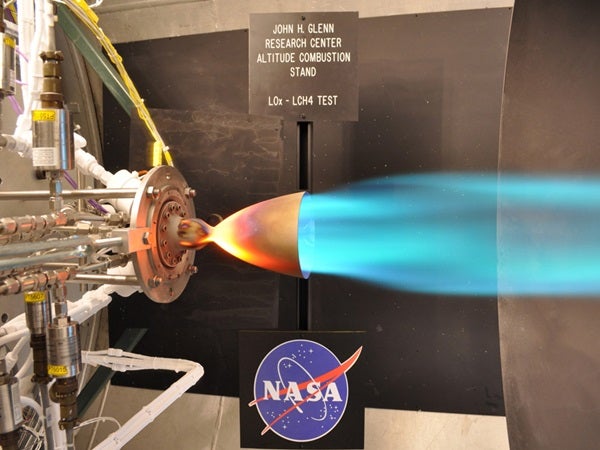Engineers have completed an extensive series of tests on a new rocket engine that will use a non-toxic propellant combination at NASA’s Glenn Research Center in Cleveland, Ohio. The reaction control engine that was tested provides 100 pounds (45 kilograms) of thrust and is typically used for spacecraft maneuvering.
The rocket engine, designed by Aerojet of Sacramento, California, uses methane and oxygen as propellants. These propellants are cryogenic liquids, or as cold as -238º Fahrenheit (-150º Celsius), and are being investigated as a non-toxic alternative to more commonly used hypergolic fuels. Hypergolic fuels ignite easily, and extreme care must be taken because the propellants can be highly toxic. The technology development’s objective is to provide risk-reduction data for this novel non-toxic propellant combination for this class of engines.
Multiple vehicle studies have shown that the oxygen and methane propellant combination has the potential for greater engine performance, which can result in lower vehicle mass and greater payload-carrying capability. Improved handling and storage characteristics are additional benefits of the methane/oxygen combination.
“The ability to efficiently conduct altitude testing with cryogenic propellants in conditions that mimic space is essential as NASA develops missions for future space exploration,” said Mark Klem, manager for the Propulsion and Cryogenic Advanced Development project at Glenn. “The benefits of this technology make it advantageous for missions that require long-duration storage of propellants in space.”
Engineers conducted a variety of tests to determine overall performance levels of the engine. Key tests already completed examined the vacuum specific impulse, or the amount of thrust produced by a given amount of propellant flowing through the engine. Testing also examined how well the engine could operate in a pulse mode such as those for changing directions in space or docking with another vehicle. During this series of tests, the engine met or exceeded all performance requirements.
Also included in the testing was a prototype compact exciter, which provides energy to the spark plug to ignite the propellants. The new exciter is almost half the weight of currently used exciter designs, thereby contributing to the reduction in mass with greater payload capability.
Engineers at Glenn expect to complete their analysis of the data generated from the tests within the next several months.
The tests mark the first major series of tests at Glenn’s Altitude Combustion Stand facility. This facility is designed to test engines in a reduced atmosphere environment that simulates the vacuum environment of space. Originally part of Glenn’s Rocket Engine Test Facility, the new facility was activated last summer after being moved as part of a Cleveland Hopkins Airport expansion project.
The new facility includes two propellant conditioning feed systems, designed by Sierra Lobo, Inc., in Milan, Ohio. They provide precise control of propellant pressures and temperature to the engine propellant inlets. These capabilities allow tests of the engine at more realistic conditions than most ground based facilities can offer, making the conditions similar to those that would be observed during actual space flight.
The testing at Glenn is funded by NASA under the agency’s Exploration Technology Development Program.










